7 Major Ports in Sweden
Ranked as the fifth biggest country in Continental Europe and the 16th richest in the world, Sweden is a highly competitive and export-oriented economy driven by the automobile, engineering, telecommunications and pharmaceutical sectors. It is rich in resources such as iron, timber and has enormous scope for generating hydropower.
Situated amidst the Baltic sea and North Atlantic Ocean, Sweden has a fairly developed commercial shipping sector with maritime connections to major ports of Europe, the Middle East and Southeast Asia.
Numerous ferry connections link the Swedish ports with Denmark, Latvia, Poland etc. High infrastructural development and ease of business have led to increased foreign investment in Sweden. The world’s prominent shipping companies operate from Swedish ports.
The country exports machinery and transportation equipment, rubber goods, chemicals, clothes, packaged and canned food, textiles, wood and furniture to Norway, Germany, the US, Denmark and Finland.
Swedish imports comprise cars, crude oil, refined petroleum, automobile parts, broadcasting equipment. Significant import partners include Germany, the Netherlands, China and Denmark.
Port of Gothenburg
Gothenburg is the biggest Scandinavian port and a crucial maritime gateway for a significant portion of the Swedish industrial sector. Situated on the western Swedish coastline, the port lies in a major industrial and commercial region which includes cities such as Oslo and the capital Stockholm. It is an ice-free port that operates all year round, giving it an added advantage over other ports of the region.
Being the country’s premier port, around 30% of the total Swedish international trade is carried through this facility which deals with all types of cargo. It has numerous sub-ports and terminals for handling containers, ro-ro, oil, energy products as well as passengers. About 41,350,000 tonnes of cargo, including 887,000 TEU and 1,700,000 passengers, frequent the port every year.
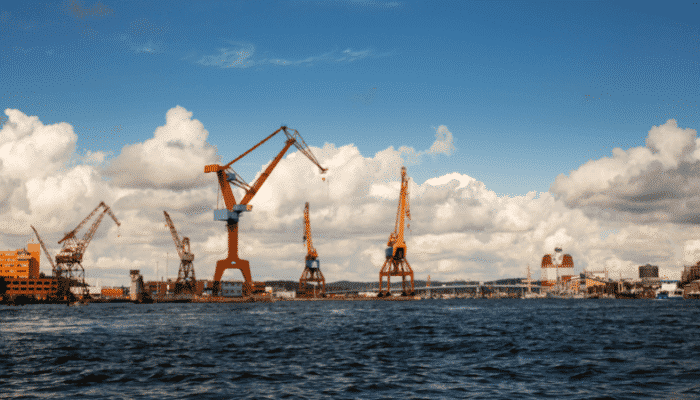
The combined length of its dock is roughly 8 miles and the entrance channel is wide enough to accommodate the world’s biggest container ships and bulk carriers. Gothenburg has direct maritime connections to major ports in 140 countries of Europe, the Middle East, Asia, Africa and North America.
Commodities exported from the port comprise steel, forest goods, paper, timber, vehicles while it handles imports of consumer products such as clothes, electrical gadgets, furniture.
It is also an important transhipment port and LPG handling facility. Three oil refineries at the Torshamnen terminal have a total annual capacity of over 10,000,000 tonnes. The Alvsborg terminal operates ferries and cruises to nearby countries.
Port of Trelleborg
Trelleborg is the biggest Roro port in the Scandinavian region comprising 13 berths including 8 ferry wharves with direct maritime routes to Rostock, Sassnitz and Travemunde. Lying on the southern end of Sweden, it is close to the border of Germany and is the second-largest port in Sweden in terms of cargo handling. In 2020, it handled around 12 million metric tonnes of cargo and 2,150,000 passengers. Equipped with an automated double ramp system and rail links it provides reliable services to its customers across the world.
Apart from handling automobiles, general and bulk cargoes such as grains, cereals, oil, fertilisers also pass through the port’s terminals. It is also the region’s intermodal hub, offering ease of transport between the Scandinavian countries and Continental Europe. Also famous as the Biggest railway facility of the Baltic sea, it operates the world’s largest railway ferries.
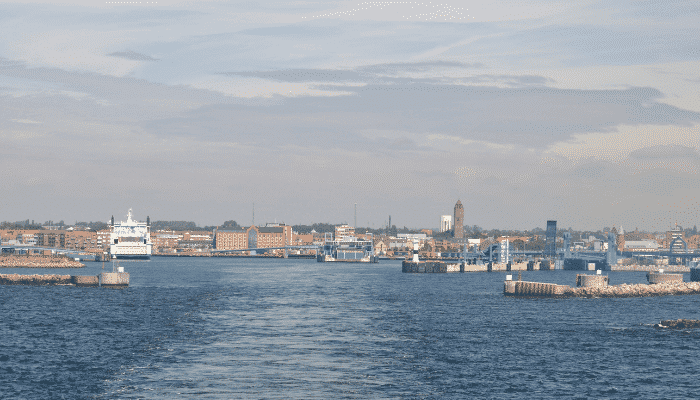
The port is divided into three main areas spanning 1,150,000 m2 with a total quay length of 5300 m. The New harbour, also known as Nyhamnen has numerous wharves on its northern and southern sides with average depths of 8 m. The southern side houses the oil handling facility with three storage tanks. The Western harbour handles general cargo and the eastern port area handles containers and bulk ships.
The port premises also comprise a logistics centre spanning 32,000 m2, directly connected with the port’s warehouse area and a solar park covering 2300 m2 producing 510,000 kWh annually.
Port of Stockholm
The Stockholm port lies on the eastern Swedish coastline and covers approximately 1755 hectares. This port lies in the town of Nynashamn, 60 km from Stockholm. It is not only a cargo handling facility but a popular vacation spot served by 10 cruise berths. The world’s biggest cruises, yachts and ferries operate from Stockholm, carrying passengers to and from Sweden, Finland, Russia and the Baltic region.
It handles exports of iron and steel goods, paper, wood pulp, machine equipment, packaged food, timber etc. Imports of mainly coal, mineral and oil products, chemicals, cooking oil, vehicles, and conventional cargo are dealt with at the Stockholm port, which sees 8,570,000 tonnes of cargo, 27,865 TEU and 9,150,000 passengers every year.

Port of Stockholm comprises subsidiary ports of Kapellskar and Nynashamn with the former serving the ports of Estonia and Finland while the latter carries freight to mainly Gotland and Baltic ports.
The Port’s oil terminal comprises 10 berths measuring 200 m each with a draft ranging from 9 to 9.5 m for handling heating oil, paraffin, petrol, and aviation kerosene. The Container terminal encompasses 4 wharves spanning 550 m with an alongside depth of 7.5 to 8.9 m for handling containerised cargo.
Served by the latest port equipment like rail-mounted container cranes and gantries, the container handling facility is also equipped with a fully automated container scanning system that drastically reduces the processing time. The port has numerous berths for handling bulk cargoes and is the region’s only deepwater facility handling a significant proportion of grain exports.
Port of Gavle/ Gefle
Gavle port lies on the Gulf of Bothnia, roughly 170 km away from Stockholm in Sweden and is the third-largest container port in the country. It is visited by 1,000 ships and handles around 4,650,000 tonnes of cargo every year. Dating back to the mediaeval period, and used by Vikings for exporting copper and iron to the region of Bergslagen, it is also an important archaeological site and a tourist destination. The port also serves as a logistics hub providing opportunities for regional maritime growth.
The Port’s bulk terminal comprises two quays namely the Eastern dock that covers 560 m and deals with scrap steel, sawn wood, alloys and clays. The Southern dock spans 290 m and has dedicated berths for handling rubber clippings, stainless scrap, paper and bulk cargo such as timber, logs, pellets, fuel chips. A separate quay spanning 110 m handles lead and zinc.

The port’s liquid bulk terminal handles petrol, ethanol, fuel etc on its two berths measuring 300 m. The oil terminal deals with more than 1.5 million tonnes of petroleum annually with a storage capacity of 750,000 m3. The container terminal became operational in 2006 and comprises 2 wharves spanning 350 m capable of accommodating 180,000 TEU of containerised cargo annually. A combi-terminal was recently constructed for handling trailers and Roro.
Port of Helsingborg
Helsingborg port lies on the southwestern tip of Sweden across the Oresund or the Sound, on the mouth of the Baltic Sea. It is the country’s most important ferry port comprising 4 harbours. It is also a popular cruise destination and vacation spot. It is frequented by 46,500 ships every year bringing 11,000,000 tourists. Also, 7,990,000 tonnes of cargo and 2,450,000 automobiles pass through the port. It is a crucial shipping hub along with extensive railways and road connections with Europe and other Scandinavian countries.
The port’s southern harbour comprises numerous terminals for handling diverse cargoes. The Skane terminals deal with Roro, project loads etc and incorporate warehouses for storing sheet steel, paper rolls, aluminium, copper and lead. It also houses one of the largest grain handling facilities of northern Europe, capable of storing 260,000 tonnes. The liquid bulk terminal mainly handles shipments of oil and petrol on its three dedicated berths.
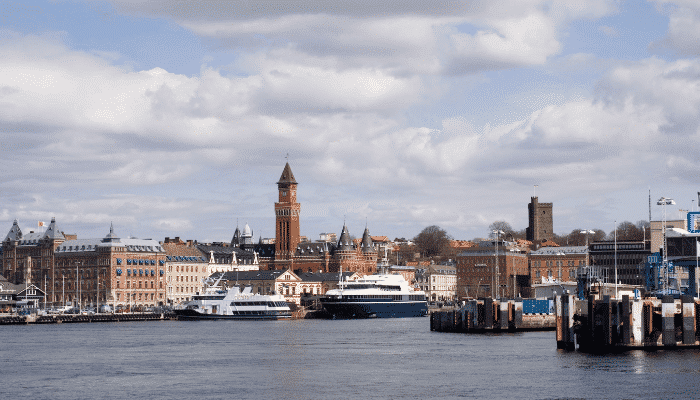
The Bulk harbour is privately owned and comprises 2 wharves covering 400 m capable of accommodating ships up to 50,000 DWT. It can store around 250,000 tonnes of dry cargo. The Western harbour deals with 280,00 TEU and is an important container handling facility. It has an additional berth for handling bulk like wood pellets. It also has three ramps for handling Roro. Spanning 190,000 sq m with a total quay length of 920 m, the western terminal can accommodate Panamax ships. The Northern Harbour lies near Knutpunkten and operates ferries to and from Helsingor in Denmark carrying vehicles, cars and passengers.
Port of Ahus
Lying on the country’s southwestern coastline, Ahus Port is Southern Sweden’s crucial bulk handling facility, with bulk comprising more than 65% of the total volume of cargo. It is also the biggest container port in the southeastern region of Sweden. More than 600 ships and 750,000 tonnes of cargo is handled by the port every year. The major exports include grains, stone, timber and alcohol while Ahus handles imports of oil, gypsum and fertilisers.
Many manufacturing companies are situated near the port such as the Absout which makes the popular Swedish vodka. The port is also famous for its eel gatherings in summers where locals and tourists come together to eat eels.
It is easily accessible with an entrance channel that is 70 m wide and 9 m deep. The port has numerous berths with a total quay length of over 1300 m capable of accommodating ships with an LOA of 135 m.
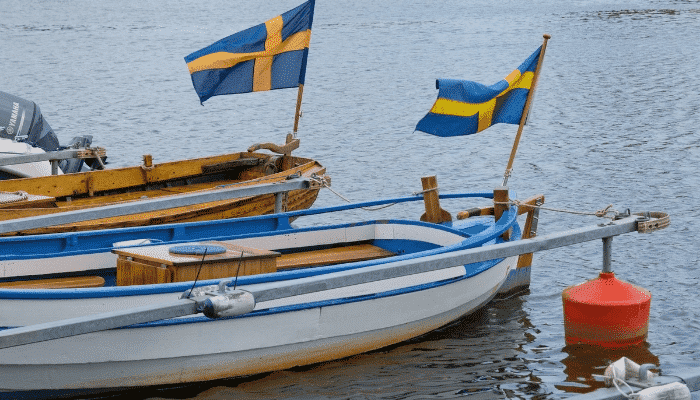
Due to the proximity of the quays with the container terminals and storage warehouses, the port offers quick loading and unloading services. The container handling area spans 22,000 m2 with a total storage capacity of 3000 TEUs. It is endowed with the latest port equipment such as shore, mobile and gantry cranes and a modern container scanning system. Ahus’s Bulk and Break Bulk terminal comprises a wharf measuring 1050 m, equipped with six cable cranes with a lifting capacity of 35 tonnes each and a siwertell screw-type unloader.
Ahus port has ample storage space covering 56,000 sq m including an unpaved storage area for containers taking 51.9,000 sq m. Sheltered storage space covers 4000 sq m and is used for keeping general cargo.
Port of Norrkoping
Norrkoping port lies in south Sweden, near the Bay of Braviken, some 50 miles from the Baltic Sea. The port city is a famous industrial area and was once known for its fine textiles. Norrkoping is a well-protected port decked with the latest port equipment and operation system for handling all kinds of cargoes such as bulk, liquid, containerised goods, and Roro.
It exports paper, grains, piece goods, timber and pulp while handling imports of coal, coke, oil and fertilisers. The total quay length is more than 5400 m with depths ranging from 6 to 12 m. About 1400 ships visit the port every year carrying over 4,350,000 tonnes of cargo.
It incorporates two major cargo handling areas namely the Inner port and the Pampas terminal which are directly linked to roadways and railways. The former can accommodate vessels weighing around 50,000 DWT carrying dry cargo and liquid bulk. It possesses Sweden’s biggest crane with a lifting capacity of over 300 tonnes.

The latter comprises 2 berths for handling Roro and 5 wharves dedicated for dealing with containerised cargo and forest goods. The deepwater Pampus terminal also incorporates a berth for handling oil tankers. It incorporates 150,000 sq m of open storage area.
Ohman terminal mainly deals with unitised and containerised cargoes. It has 2 fairways with depths of 9 m and a total length of over 350 m. It has a maximum container storage capacity of 3500 TEUs and a total cargo storage capacity of 100,000 TEUs. Lastly, the Djuron Grain facility is significant for the local economy since it is used by the farmers of Sweden for exporting their products.
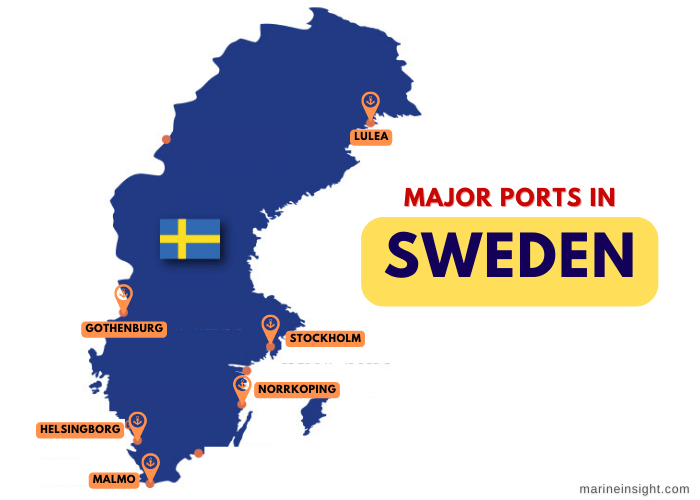
You might also like to read:
- 6 Major Ports in Finland
- 2 Major Ports in Monaco
- 10 Major Ports in Europe
- 15 Major Ports in Spain
- 10 Major Ports In Germany
Disclaimer :
The information contained in this website is for general information purposes only. While we endeavour to keep the information up to date and correct, we make no representations or warranties of any kind, express or implied, about the completeness, accuracy, reliability, suitability or availability with respect to the website or the information, products, services, or related graphics contained on the website for any purpose. Any reliance you place on such information is therefore strictly at your own risk.
In no event will we be liable for any loss or damage including without limitation, indirect or consequential loss or damage, or any loss or damage whatsoever arising from loss of data or profits arising out of, or in connection with, the use of this website.
Do you have info to share with us ? Suggest a correction
Disclaimer :
The information contained in this website is for general information purposes only. While we endeavour to keep the information up to date and correct, we make no representations or warranties of any kind, express or implied, about the completeness, accuracy, reliability, suitability or availability with respect to the website or the information, products, services, or related graphics contained on the website for any purpose. Any reliance you place on such information is therefore strictly at your own risk.
In no event will we be liable for any loss or damage including without limitation, indirect or consequential loss or damage, or any loss or damage whatsoever arising from loss of data or profits arising out of, or in connection with, the use of this website.
Latest Maritime Knowledge Articles You Would Like:
Subscribe To Our Newsletters
By subscribing, you agree to our Privacy Policy and may receive occasional deal communications; you can unsubscribe anytime.















